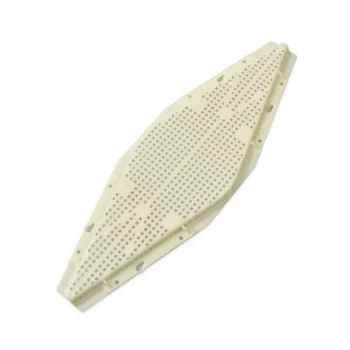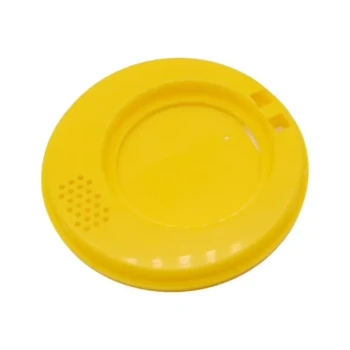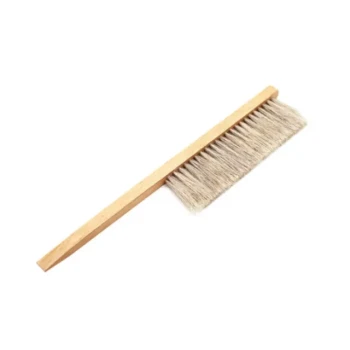Removing the queen excluder at the end of summer is a critical step for winter hive preparation. This simple action allows the queen to move freely with the rest of the colony as they migrate upwards during the cold months. If left in place, the excluder traps the queen in the lower, colder part of the hive, separating her from the cluster and its food source, which is a virtual death sentence for the entire colony.
The core issue is a conflict between a summer management tool and the colony's natural winter survival strategy. The queen excluder, designed to contain the queen, becomes a fatal barrier that prevents her from staying within the warmth and safety of the winter bee cluster as it moves up toward its honey stores.
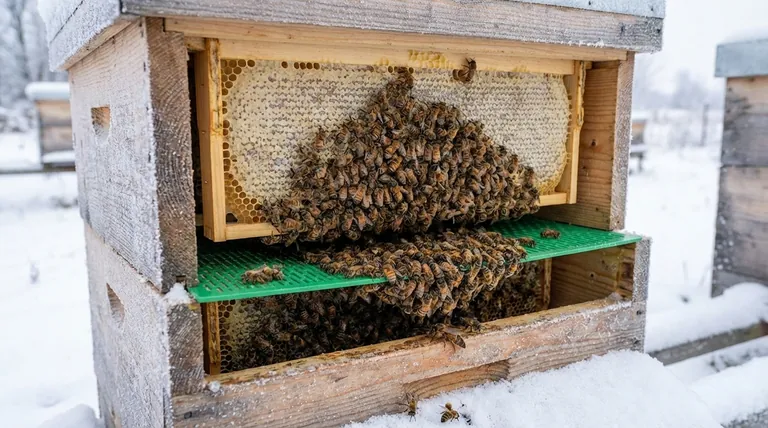
The Physics of the Winter Bee Cluster
To understand why the excluder is so dangerous in winter, we first need to understand how a honeybee colony survives freezing temperatures.
How Bees Generate Heat
Honeybees do not hibernate. Instead, they form a tight ball known as a winter cluster.
By huddling together and vibrating their wing muscles, the bees generate metabolic heat. This allows them to maintain a survivable temperature at the center of the cluster, even when it's freezing outside.
The Queen's Central Role
The queen is always protected at the warmest, most central point of this cluster. The survival of the colony depends entirely on her survival, so the workers will dedicate all their energy to keeping her warm and fed.
The Slow March Upwards
As winter progresses, the cluster slowly consumes its honey stores. Since beekeepers typically leave honey stores in the boxes above the brood chamber, the cluster must gradually move upwards to stay in contact with its food. Heat also rises, making the top of the hive the warmest place to be.
How the Queen Excluder Becomes a Fatal Trap
The queen excluder is an invaluable tool during the summer honey flow, but it becomes a significant liability as the season changes.
A Summer Tool, a Winter Hazard
In summer, the excluder's purpose is to keep the larger queen in the brood boxes, preventing her from laying eggs in the honey supers you intend to harvest. The smaller worker bees can easily pass through to store nectar.
The Inevitable Separation
When winter arrives, this size difference creates a deadly problem. As the cluster begins its natural upward migration toward the honey, the worker bees can move through the excluder, but the queen cannot.
The cluster is then faced with an impossible choice: abandon its queen to die below, or stay with her and starve because they can't reach the honey above. In nearly all cases, the drive for food and warmth wins, and the cluster will slowly move away, leaving the queen behind.
The Guaranteed Outcome
Once separated from the cluster's warmth, the queen will quickly freeze and die. Without a queen, the colony is doomed and will perish before spring.
Understanding the Geographic Context
While removing the excluder is a firm rule in many places, the urgency depends entirely on your climate.
A Non-Negotiable Step in Cold Climates
In regions with long, bitterly cold winters, such as the Northern Hemisphere, removing the queen excluder is mandatory. The severe temperatures force a tight cluster and a distinct upward migration, making separation a near certainty if the excluder is left on.
Less Critical in Milder Regions
In areas with mild winters, like much of Australia, the practice is less common. Brood rearing may continue year-round, and the cluster may not need to move as dramatically to survive. However, even in these areas, removing the excluder is a safe practice that eliminates any potential risk.
A Simple Rule for Colony Survival
Your decision should be based on a clear understanding of your local climate and the bees' fundamental needs.
- If your primary focus is colony survival in a region with freezing winters: You must remove the queen excluder before your first hard frost.
- If your primary focus is simplifying management in a mild climate: You may be able to leave the excluder on, but removing it is still the safest and most recommended course of action.
Ultimately, aligning your management with the colony's natural winter behavior is the key to successful beekeeping.
Summary Table:
| Key Action | Purpose | Consequence of Inaction |
|---|---|---|
| Remove Queen Excluder | Allows queen to migrate with the winter cluster to warmth and food. | Queen is trapped below, freezes, and the colony dies. |
| Timing: Before First Hard Frost | Aligns beekeeping practice with the colony's natural winter survival strategy. | The cluster abandons the queen to move up to honey stores, leading to colony collapse. |
Ensure your apiary is ready for winter. Protect your investment and guarantee your colonies survive the cold months. HONESTBEE supplies durable, reliable beekeeping supplies and equipment to commercial apiaries and distributors. Let us help you prepare. Contact our wholesale experts today to discuss your winter equipment needs.
Visual Guide
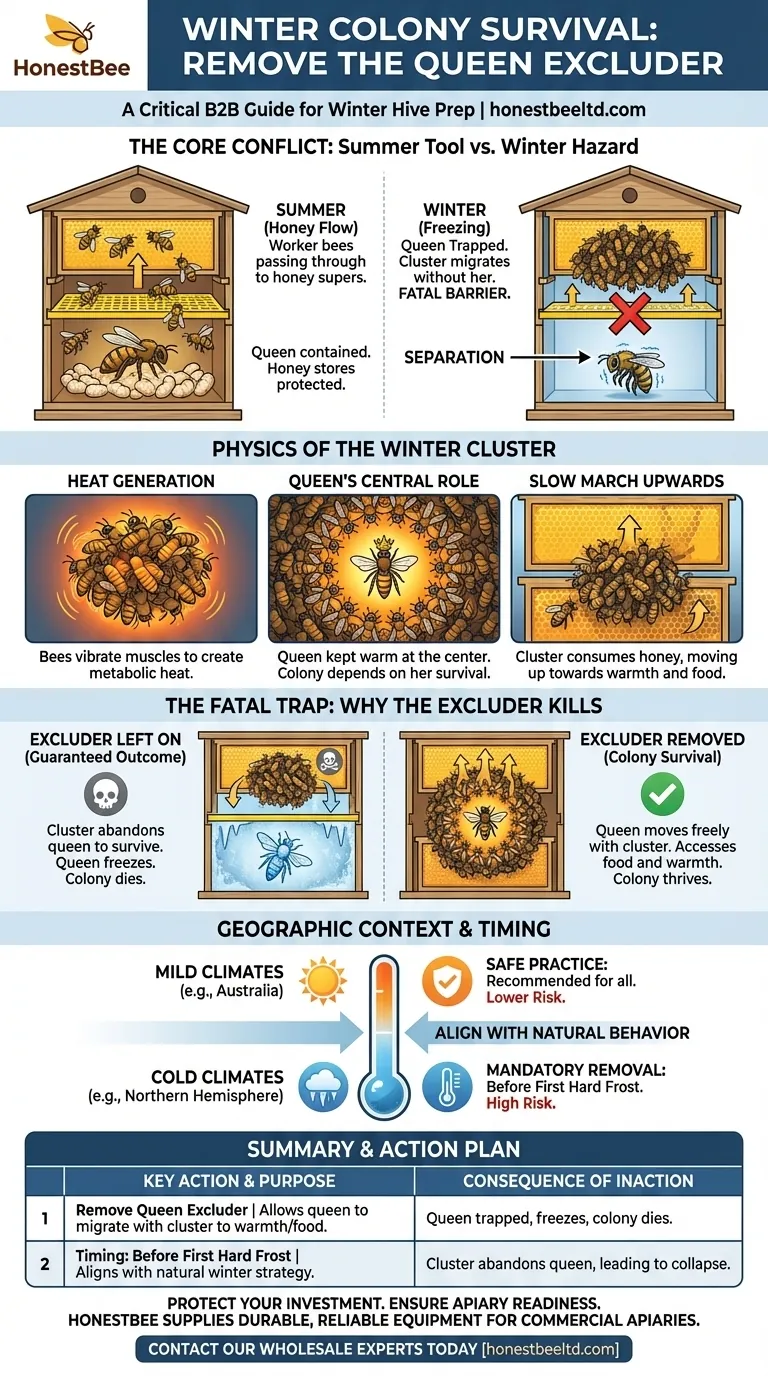
Related Products
- High Performance Plastic Queen Excluder for Beekeeping and Apiary Management
- Professional Plastic Queen Excluder for Modern Beekeeping
- Wooden Queen Bee Excluder for Beekeeping
- Premium Wood Framed Metal Wire Queen Bee Excluder
- Plastic Queen Bee Excluder for Bee Hive Wholesale
People Also Ask
- Why don't all beekeepers use Queen Excluders? Balancing Honey Purity with Hive Productivity
- How does a queen excluder affect honey storage? Maximize Clean Honey Yields in Your Hive
- What are the benefits of a queen excluder? Ensure Pure Honey & Simplify Hive Management
- What impact does a queen excluder have on colony defensiveness? Control Hive Temperament for Safer Beekeeping
- When is the typical time frame for harvesting honey and removing the queen excluder? Optimize Your Hive Management









